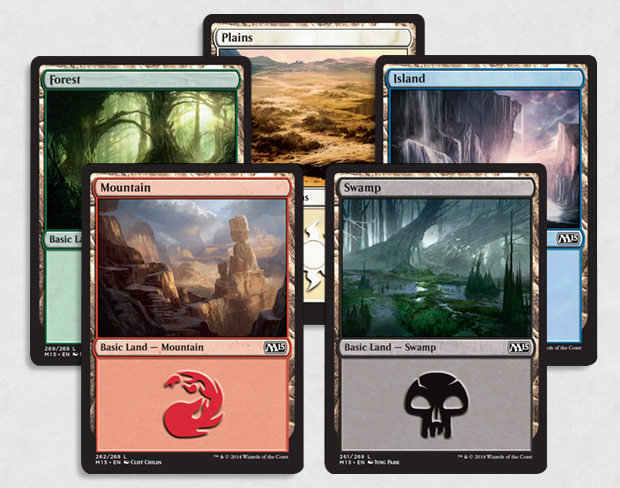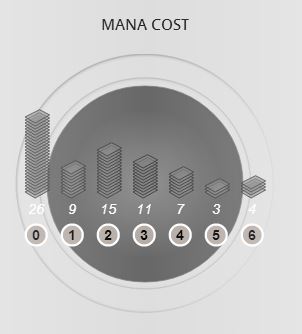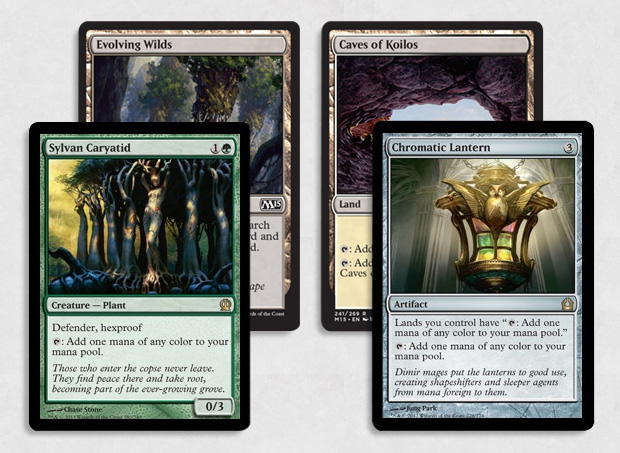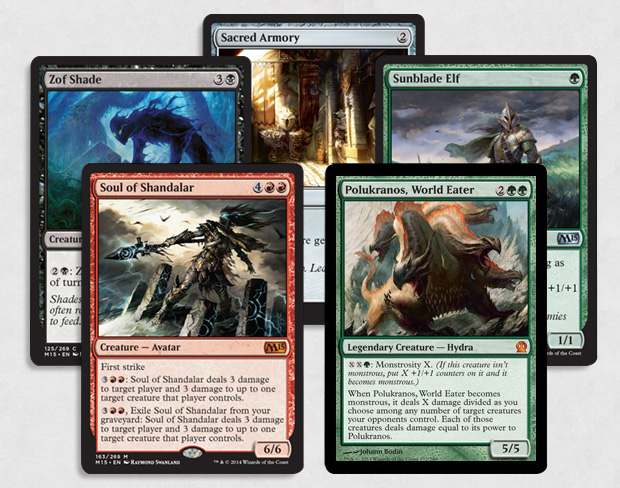The Basics of Mana
Virtually every game of Magic begins the same way: a player plays a land. Everything starts with mana. It's one of the most basic and important resources of Magic. Without it, you simply can't play the game.
Last week's focus was on Magic's gameplay, but today I'll be touching on one of the other majorly important aspect of the game: deck building. Mana is central to both gameplay and deck building, so understanding it is the first step toward mastering Magic. Two of the most important concepts, when it comes to deck building, are mana base and mana curve.
In the same way that you can't cast a spell if you can't get the proper mana, mana is also a limiting factor when it comes to deck building. You can only play with creatures and spells if your mana base can support them.
The Mana Base
The term mana base refers to a deck's lands and any supplemental ways to produce mana, such as anything along the lines of Elvish Mystic or Verdant Haven. A mana base can be simple (say, seventeen Plains in an all-white, 40-card deck) or it can be quite complex: featuring multiple colors of mana, lands with unusual abilities, and indirect methods of making mana (via artifacts, creatures, or spells).
There are no hard and fast rules about what a mana base should look like; any guidelines I can offer might need to be adjusted or completely scrapped under certain circumstances. However, what I can give you is a helpful starting point.
How Many Lands to Play
Traditional knowledge is that lands should make up a touch over 40% of a deck. This means about 17–18 lands for a 40-card deck and about 24–25 lands for a 60-card deck. This is a tried-and-true structure that's worked for many players for many years. You'll rarely be making a big mistake if you always stick to such a guideline. That said, there are a number of factors that might make you consider small adjustments.
Consider if you have any nonland ways to produce mana. The presence of creatures like Elvish Mystic and Voyaging Satyr might impact the number of lands your deck needs to function.
The correlation isn't one-to-one—as in thinking one Elvish Mystic or Voyaging Satyr equals one land—for a number of reasons. First, you cannot cast them unless you have lands already. Second, they're less reliable because they're easier for your opponent to kill. Third, you'd normally play cards like these in order to jump ahead in mana, but you still want to play a land every turn, at least for the first few turns. These cards shouldn't be counted directly as lands, but three copies of Elvish Mystic can be a fine reason to play, say, sixteen lands instead of seventeen or eighteen in your 40-card Limited deck.
An equally important question is, simply, how expensive are the cards in your deck? If all of your spells cost four mana or less, you won't need as many lands as a player sporting multiple cards that cost seven or eight mana.
Colored Mana
A question that can be even more challenging is that of how to balance your colored mana requirements. There's not much to it if you're only playing one color, but once you get into the realm of playing three or more colors, things get a little hairy.
Often in Magic, you'll be presented with small tradeoffs between power and consistency. The more colors you play, the wider the range of cards you have access to. So it's likely that your deck will be capable of more powerful draws when everything runs smoothly. However, when you play more colors, it also becomes more likely that you'll be stuck without the proper colors of mana to play one of your spells, which will lower the consistency (or reliability) of how your deck functions.
Finding the right balance of power and consistency can be tricky. When it comes to a mana base, one important question is: What tools do you have access to?
In the simplest case, you'll only have basic lands (Plains, Island, Swamp, Mountain, and Forest) to work with.

When you're working with basic lands, a two-color deck is virtually always where you'll strike the right balance between power and consistency. If you only want to play one color, that's a perfectly fine choice, but if there's an appealing card that you'd like to play in a second color, you can feel safe in doing so. With two colors, you'll be able to cast both colors of spells in most games (not all games, but what most players would consider "an acceptably high" portion of games). With more than two, you'll begin to notice problems.
However, that's a description of the simplest case. A deck builder is like a carpenter—the better the tools the carpenter has access to, the more complex projects he or she can undertake. Nonbasic lands, as well as nonland ways to produce mana, can be quite powerful, and can assist you in playing multiple colors in your deck.
If you have access to a bevy of cards like these, which have the ability to produce multiple colors of mana, you can begin to feel comfortable playing a three-color deck if you choose to. Playing with more than three colors is a rather advanced technique; I recommend against it until you feel very comfortable with two- and three-color decks.
Even when playing multiple colors, it can be in your best interest to center your deck primarily around one or two colors, and be a little bit less reliant on the rest. Say, for example, you have a sealed deck that's primarily red and green, but you want to play with one copy of Garruk, Apex Predator. It might be fine to only play with four or five sources of black mana in your deck. You'll often find a way to make black mana by the time you're ready to cast your Garruk, and even if you don't, having one card stuck in your hand for a little while isn't a complete catastrophe. This is commonly referred to as splashing a color.
To play a deck equally reliant on all three colors of mana is possible, but difficult. After all, the more things that can go wrong, the less often things will go exactly right. Here are a few more guidelines to use as a starting point:
- For a 40-card deck, if you really want to have a land that produces a certain color of mana in your opening hand, you should play at least ten lands that produce that color (eleven or twelve to be safe).
- For a 60-card deck, you should play at least fifteen or sixteen lands that produce that color (seventeen or eighteen to be safe).
The Mana Curve
Everything starts with mana. The question of mana isn't fully answered once you've decided how many and what types of lands to play. It also influences what spells you play with and the overall structure of your deck.
The mana curve refers to the balance that deck builders should aim for between cards of varying mana costs—cheap cards and expensive cards. You can also refer to a deck as having a "high mana curve" or a "low mana curve." It would be a mistake to play with all cards that cost five mana, because you'd have nothing to play in the first four turns of the game!
On the other hand, if your deck was made up entirely of weaker, one-mana spells, you wouldn't be making the best possible play on any turn beyond the first one. There's a lot of value in having at least a couple of cards of each mana cost.

Like most things, the mana curve is not an exact science. Players often search for "master formulas" for how many cards you should play with at one mana, two mana, three mana, etc. But the fact is that it's a question that depends a lot on context. What cards do you have access to? What's your strategy for winning the game? What are your opponents likely to be doing at each point in the game?
The concept of the mana curve is important to all decks, but it's most clearly illustrated in the case of a fast creature deck. If your goal is to play creatures and unload a lot of damage very quickly, you really want to come out of the gates starting on turn one or turn two. Some 60-card creature decks have been known to play twelve, fourteen, or even more creatures that cost one mana!
Again, this is a question of strategy. If your goal is not to win with a quick creature rush, playing dozens of one- and two-mana creatures will water down your deck and reduce the number of more powerful spells that you can play with. You should have some plays that you can make early in the game, but there's no mystical number for how many it should be. Ask yourself how fast your opponents are likely to be. Do you have to start defending yourself right on turn one, or might it be okay if you sometimes don't play anything until turn three?
Mana "Hosed" and Mana "Flood"
It's a sad fact, but every new player learns these concepts early in his or her Magic career. "Mana hosed" is one slang term for when you don't draw as many lands as you want, and "mana flood" means that you've drawn far too many. These things can happen to any player, with any deck, at any level of competition—it's simply part of the game.
But not to worry! Although any one particular game where you get mana hosed might be aggravating and unfun, variance in the number of lands you can draw is actually something that enriches Magic and helps to make it the game it is.
There are things you can do to manage being mana hosed and mana flood, both in deck building and in gameplay. It all starts with doing a good job in building your mana base and your mana curve, but here are a few other tricks you can use.
To mitigate the risks of mana flood, one thing you can do is look for mana sinks. Mana sinks are cards that, while not necessarily expensive in themselves, can make use of your extra mana in late-game scenarios.
Note that it's completely normal to draw eight, nine, or even more lands in the course of a long game. When you have a mana sink in play, you might still prefer to draw more spells, but when you inevitably start drawing more lands than you need, at least you can put them to some use.
If your goal is to mitigate the effects of being mana hosed, you can look for cheap cards that have the capability to answer or trade with more expensive cards.
My best piece of advice is simply to recognize that drawing the wrong number of lands is a normal part of the game. Try your best not to be frustrated by it. A common pitfall for a new player is to overcompensate by adding or removing lands from a deck after every mana hosing or mana flood. If, after a couple of dozen games, you notice a pattern of things working out poorly, it's good to learn from that and be ready to adapt. The point is not to let short-term frustration overcome rational decision-making.
Example: Grand Prix Portland
By way of example, here's a 40-card deck that I played with in a recent tournament.
Right off the bat, I've already deviated from one of the recommended formulas offered. It's true that almost all 40-card decks should play with either seventeen or eighteen lands, but in this case extreme circumstances led me to deviate and play with nineteen lands instead.
For one thing, this deck has a relatively high mana curve. I have a spell that costs eight mana, and no creatures that cost two or less! You can consider this a mistake on my part, as it's typically very important to have at least a handful of cards that cost less than three mana. However, I had to build my mana base for the cards that I had, not for the cards that I wished I had.
Second, my deck has plenty of mana sinks. Two copies each of Jorubai Murk Lurker and Zof Shade, as well as Gargoyle Sentinel, all have activated abilities that can make use of extra mana. Unmake the Graves, Gravedigger, Divination, and Sign in Blood would help make sure I always had cards in my hand that I could cast.
All in all, I felt that I had a lot to do with my mana, so the risk of mana flood was relatively low. On the other hand, because of my shortage of early plays, getting mana hosed was very possible, and would be particularly devastating. Therefore I erred on the side of too many, rather than too few, lands.
Now let's discuss the colored mana. I built this deck to be three colors, something I felt comfortable with due to the presence of three Evolving Wilds. Moreover, the deck is centered around black and blue, with only one Lightning Strike as a red splash. Evolving Wilds would normally search for Swamps and Islands, but I could simply put one Mountain in my deck, and have a good chance of finding it when it was needed.
Finally, I had to choose how many to play each of Swamps and Islands. I would need to draw both types of lands in order to function, and would preferably want two of each. To maximize the chances of drawing two of each, I wanted an even split. However, with an odd number of slots (fifteen) to devote to them, I needed to play either one extra Swamp or one extra Island.
The biggest deciding factor was that one of my cheapest spells, Sign in Blood, cost two black mana. I wanted to maximize the chance of having two black mana in my opening hand, so I played one extra Swamp.
Hopefully that example gave a basic sense of what you should be thinking about when building a mana base.
If your deck has a good mana base and a balanced mana curve, you've managed to avoid the number one pitfall of aspiring deck builders. Remember, everything starts with mana! If you can make your mana serve you well, instead of feeling helpless against awkward mana draws, you're well on your way to success.



